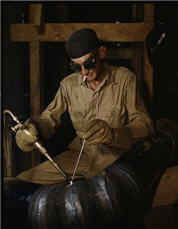PropaneTorch (Download)
Propane Torch 1 Propane Torch A propane torch consists of propane gas and an igniter to create a flame, which can be used for numerous applications. Propane torches can reach 3,623 º F or 5,110 ºF when in conjunction with pure oxygen (example below). There are many types of propane torches ranging from simple handheld bottle mounted torches to large propane rigs in which the torch nozzle is connected through a long hose. 2 History of Propane Torches In 1918 J.B Anderson developed the first propane fueled pump-less blow torch. Some of the first propane torch kits were marketed as early as the 1960’s . 3 Uses of Propane Torch Propane torches are frequently used to solder copper water pipes (commonly called sweating ) or for brazing dissimilar metals. 4 Uses of Propane Torch A few more applications for using propane torches are thawing ice, applying bitumen for roof applications, and (in special applications) for cutting and welding metal. 5 Typical Hazards and Safety Concerns Combustion by-products from propane torches contain carbon monoxide which can cause cancer and birth defects. Because of the extreme heat, burns are a common hazard and extreme caution should be taken. Most burns occur when matches or lighters are used to ignite the torch instead of recommended strikers. Flash Back- when the flame retreats into the torch because of improper pressures or a clog. The valve should be shut off immediately Backfire – occurs when the flame extinguishes with a loud pop. Touching the torch tip against the work material or insufficient gas pressure can cause backfires and startle the operator 6 There were 7 Fatalities investigated by OSHA in the period of 1990 thru 2009 in which propane torches were specifically identified as having a causal influence. “Source: Extracted from OSHA Accident Investigation Data 1990-2009” 7 Fatality Description A worker entered into a confined space with a lighted torch. The atmosphere was not tested and already had a high concentration of propane gas. The gas exploded and killed him. “Source: Extracted from OSHA Accident Investigation Data 1990-2009” 8 Fatality Description A worker was using a torch in a cooled asphalt tanker that was 2/3 full. The material caught fire in the confined space and he died of asphyxia. Source: Extracted from OSHA Accident Investigation Data 1990-2009” 9 Fatality Description A worker was cutting a sump from a flammable liquid storage tank for scrap metal. The top of the sump was open but the bottom was not. The torch cut into the sealed compartment and it exploded sending him 60 feet in the air, probably dying before hitting the ground. Source: Extracted from OSHA Accident Investigation Data 1990-2009” 10 Fatality Description A worker used a torch to cut two locks to a magazine storing explosives. He escaped injury when he cut the first lock but after the second lock was cut the magazine exploded. Source: Extracted from OSHA Accident Investigation Data 1990-2009” 11 Fatality Description Because of freezing temperatures, two workers made a make-shift heater inside a connex storage trailer using a propane torch. Later in the shift, the worker found his co-worker unconscious and unresponsive. The worker was later pronounced dead due to carbon monoxide intoxication. Source: Extracted from OSHA Accident Investigation Data 1990-2009” 12 Fatality Description A worker was cutting steel beams under a roof structure using a propane cutting torch. After cutting the lower end of one beam, the roof structure failed and the worker was struck by falling steel and he died at the scene. Source: Extracted from OSHA Accident Investigation Data 1990-2009” 13 Fatality Description Three workers were scrapping valves from a heat exchanger using a propane cutting torch. They began to cut into the lower part of a 10 inch pipe which had trapped residual natural gas liquids which sprayed out and quickly ignited. One worker was pronounced dead at the scene due to injuries related to the explosion. Source: Extracted from OSHA Accident Investigation Data 1990-2009” 14 OSHA Regulations Ensure that portable heaters/blow torches are equipped with automatic shut-off devices to stop the flow of gas in the event of flame failure, in accordance with 29 CFR 1926.153(h)(8). Take precautions to provide sufficient ventilation to ensure proper combustion when operating portable heaters/blow torches in confined spaces, in accordance with Title 29 Code of Federal Regulations, Part 1926.154(a)(2). 15 Safe Work Practices Personal Protective Equipment (PPE) Goggles, possibly Tinted Face Shield Gloves Long Pants Long-sleeved shirt Apron 16 Safe Work Practices 1. Assess the work that will be done, such as in a confined space or from an elevated position. 2. If necessary measure the air quality with a air monitor, especially when in a confined space. 3. Keep a well ventilated work space. 4. Inspect for propane leaks or equipment failure that can be observed before igniting the torch. 5. Keep safe distances from others in the work area 6. Use proper PPE. 17 Safe Work Practices 7. Keep a fire extinguisher nearby. 8. Ignite the torch using a striker, not a match or lighter. 9. Stop every few minutes to check the air quality. 10. Never point the flame at combustible materials. 11. Extinguish the flame when completed . 12. Once work is complete, secure the propane cylinder in a level upright position. 18 Think Safety Work Safely 19

